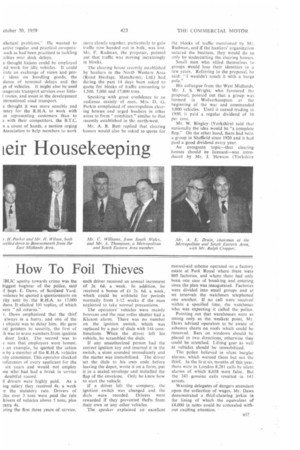How To Foil Thieves
Page 71

If you've noticed an error in this article please click here to report it so we can fix it.
JBLIC apathy towards crime was the biggest bugbear of the police: said
Supt. E. Daws, of Scotland Yard. [vidence he quoted 'a questionnaire on rity sent by the R.H.A. to 17,000 'biers. It elicited 101 replies, of which vere "nil returns."
r. Daws emphasized that the thief always in a hurry, and one of the objects was to delay him. He gave ral pointers to security, the first of it was to erase numbers from ignition door locks. The second was to e sure that employees were honest. an example, he quoted the action n by a member of the R.H.A. vehicles rity committee. This operator checked references of every applicant for the six years and would not employ me who had had a break in service doubtful record.
[1 drivers were highly paid. As a ing salary they received 4s. a week ,e the statutory rate. Drivers of :les over 3 tons were paid the rate irivers of vehicles above 5 tons, plus extra 4s.
iring the first .three • years of service, each driver received an annual increment of 2s. 6d. a week. In addition, he received a bonus of £1 2s. 6d. a week, which could be withheld for periods normally from 1-12 weeks if the man neglected to take normal precautions.
The operators' vehicles were mainly boxvans and the rear roller shutter had a Klaxon alarm. There was no number on the ignition switch, which was replaced by a pair of dials with 144 combinations. When the driver left his vehicle, he scrambled the dials.
If any unauthorized person had the correct ignition key and inserted it in the switch, a siren sounded immediately and the starter was immobilized. The driver set the dials to his own code before leaving the depot, wrote it on a form, put it in a sealed envelope and initialled the flap of the envelope. Only he knew how to start the vehicle.
If a driver left the company, the ignition switch was changed and the dials were recoded. Drivers were rewarded if they prevented thefts from their own or any other vehicles.
The speaker explained anexcellent mutual-aid scheme operated on a factory estate at Park Royal where there were 860 factories, and where there had only been one case of breaking and entering since the plan was inaugurated. Factories were divided into small groups and at set intervals the watchmen telephoned one another. If no call were received within a specified time, the watchman who was expecting it called the police.
Pointing out that warehouses were as strong only as the weakest point, Mr. Daws advised operators to be aware of asbestos sheets on roofs which could be removed. Bars on windows should be placed in two directions, otherwise they could be stretched. Lifting gear as well as vehicles should be immobilized.
The police believed in silent burglar alarms, which warned them but not the thief. In the first six months of this year, there were in London 8,281 calls by silent alarms of which 8,038 were false. Rut the 243 genuine calls resulted in 143 arrests.
Warning delegates of dangers attendant upon the collection of wages, Mr. Daws demonstrated a thief-cheating jerkin in the lining of which -the equivalent of £4,000 in notes could be concealed -with
out exciting attention. • •




















































































































